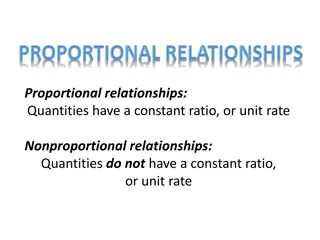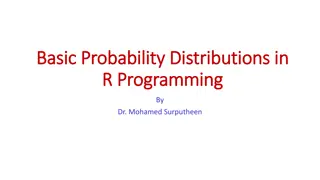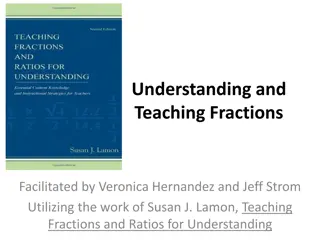Power Distribution in Data Centers Overview
Power distribution and equipment play crucial roles in commercial data center infrastructure, ensuring reliable and efficient operations. Adequate power routing from the grid or generators to data center equipment is vital for stable operations, data integrity, and performance maintenance. This incl
4 views • 19 slides
Physical Distribution
Physical distribution is a critical aspect of business operations involving the planning, implementation, and control of the flow of goods from origin to consumer. Philip Kotler and William J. Stanton have defined physical distribution as a process of managing the movement of goods to meet consumer
0 views • 8 slides
Effective Management of Transportation and Distribution in the Supply Chain
Understanding the methods to optimize the supply chain through inventory management, basic functions of transportation and distribution management, distribution strategies, importance of creating visibility in transportation and distribution activities, and the role of technology in enhancing operat
6 views • 27 slides
Distribution System Operation and Automation Overview
Distribution system operation involves various switching activities like restoration after outages, substation maintenance, load transfers, and more. A midsize US utility typically executes 10 to 20 switching orders daily. Distribution automation (DA) aims to improve supply reliability and efficienc
14 views • 36 slides
Distribution and Density of Population.
Population distribution and density are closely related concepts that describe the spatial patterns and proportional relationships of human populations across the world. Factors such as physical landscapes, socio-cultural influences, and demographic trends contribute to the regional disparities in p
9 views • 9 slides
Determining Sample Size for Research Studies: Factors and Considerations
Sample size estimation in research is a crucial step that involves various factors such as effect size, population standard deviation, power of the experiment, and significance level. The effect size indicates the practical significance of research findings, with common measures like Cohen's d and P
1 views • 24 slides
Understanding Comminution and Particle Size Reduction in Pharmaceutical Processes
Comminution is the process of reducing particle size from larger to smaller particles, crucial in various industries like pharmaceuticals. This operation involves milling, grinding, and size reduction to make raw materials usable. The particle size plays a significant role in pharmaceutical formulat
2 views • 50 slides
Understanding Proportional and Nonproportional Relationships in Mathematics
Proportional relationships involve quantities having a constant ratio or unit rate, while nonproportional relationships lack this constant ratio. By examining examples such as earnings from babysitting and costs of movie rentals, we can grasp the differences between these two types of relationships.
2 views • 6 slides
Understanding Energy Analysis in Size Reduction Equipments
This comprehensive overview delves into the energy analysis involved in size reduction equipment, exploring topics such as objectives of size reduction units, sieve analysis for particle size distribution, mesh number system, and mathematical models for energy analysis in size reduction units. Dr. J
0 views • 11 slides
Understanding Multinomial Distribution in Statistical Analysis
Multinomial Distribution is a powerful tool used in statistical analysis to model outcomes of events with multiple categories. This distribution is applied to scenarios where each trial has several possible outcomes, and the sum of probabilities of all outcomes is equal to 1. By defining random vari
0 views • 8 slides
Understanding Electric Charges and Fields in Physics
Electrostatics is the study of forces, fields, and potentials arising from static charges, including positive and negative charges which interact based on the principles of like charges repelling and unlike charges attracting. By convention, electrons are considered negative, while protons are posit
0 views • 12 slides
Understanding Proportional Odds Assumption in Ordinal Regression
Exploring the proportional odds assumption in ordinal regression, this article discusses testing methods, like the parallel lines test, comparing multinomial and ordinal logistic regression models, and when to use each approach. It explains how violating the assumption may lead to using the multinom
0 views • 13 slides
Key Management and Distribution Techniques in Cryptography
In the realm of cryptography, effective key management and distribution are crucial for secure data exchange. This involves methods such as symmetric key distribution using symmetric or asymmetric encryption, as well as the distribution of public keys. The process typically includes establishing uni
1 views • 27 slides
Understanding Data Distribution and Normal Distribution
A data distribution represents values and frequencies in ordered data. The normal distribution is bell-shaped, symmetrical, and represents probabilities in a continuous manner. It's characterized by features like a single peak, symmetry around the mean, and standard deviation. The uniform distributi
1 views • 23 slides
Understanding Size and Spacing of Rural Settlements in Geography Research
This presentation delves into the significant influence of size and spacing on the distribution pattern of rural settlements. It explores how factors like population size, areal size, topography, soil fertility, and more impact the density and distribution of settlements, categorizing them based on
1 views • 15 slides
Drug Product Distribution Procedures and Records
Written procedures and distribution records are crucial for the efficient distribution of drug products. Procedures should prioritize the distribution of the oldest approved stock first and enable easy recall if necessary. Distribution records must be maintained and indexed for accountability. Diffe
0 views • 10 slides
Understanding Normal Distribution and Its Business Applications
Normal distribution, also known as Gaussian distribution, is a symmetric probability distribution where data near the mean are more common. It is crucial in statistics as it fits various natural phenomena. This distribution is symmetric around the mean, with equal mean, median, and mode, and denser
1 views • 8 slides
Understanding Sample Size and Effect Size in Medical Statistics
Explore the crucial aspects of power analysis, sample size determination, effect size estimation, and their interrelations in medical statistics. Learn how these components influence experimental design and decision-making in research studies. Discover the significance of adequately balancing sample
0 views • 46 slides
Understanding Binomial Distribution in R Programming
Probability distributions play a crucial role in data analysis, with the binomial distribution being a key one in R. This distribution helps describe the number of successes in a fixed number of trials with two possible outcomes. Learn about the properties, probability computations, mean, variance,
2 views • 30 slides
Understanding Proportional Relationships in Everyday Scenarios
Exploring proportional relationships through real-life examples such as pricing at a frozen yogurt store, recipe quantities, and earnings calculation to demonstrate the concept and application in various situations. Proportional relationships ensure that quantities change in a consistent ratio, lead
0 views • 5 slides
Understanding Proportional Relationships in Mathematics
Explore the concept of proportionality using graphs, tables, and ratios. Learn how to determine if a relationship is proportional by analyzing ratios y:x and the constant of proportionality. Practice exercises and examples provided for better comprehension.
0 views • 22 slides
Understanding Ratios, Proportional Relationships, and Slope in Math
Explore the concepts of ratios, proportional relationships, constant rate of change, and slope in mathematics. Learn how to find constant rates of change from tables and graphs, calculate slope using points on a line, and understand direct variation between two quantities. Dive into examples to gras
0 views • 16 slides
Overview of gologit2: Generalized Logistic Regression Models for Ordinal Dependent Variables
gologit2 is an advanced program for estimating generalized logistic regression models, including proportional odds, generalized ordered logit, and partial proportional odds models. It offers features beyond traditional ologit, allowing for less restrictive and more parsimonious modeling of ordinal d
0 views • 27 slides
Understanding the Central Limit Theorem in Statistics
This lesson covers the Central Limit Theorem, which states that the sampling distribution of a sample mean becomes approximately normal as the sample size increases, regardless of the population distribution. It explains how the distribution of sample means changes shape and approaches a normal dist
0 views • 7 slides
Mastering Proportional Reasoning with Percents
Delve into the world of proportional reasoning with percents through examples like finding a percentage of a number, estimating percentages, and using percent proportions to compare quantities. Understand how to calculate percentages, estimate values, and solve problems involving percents effectivel
0 views • 26 slides
Understanding Chi-Square and F-Distributions in Statistics
Diving into the world of statistical distributions, this content explores the chi-square distribution and its relationship with the normal distribution. It delves into how the chi-square distribution is related to the sampling distribution of variance, examines the F-distribution, and explains key c
0 views • 23 slides
Understanding Proportional Relationships Through Real-Life Examples
Explore the concept of proportional relationships through various real-life scenarios like game purchases, concert tickets, and ages of siblings. Learn to identify if two quantities have a proportional relationship by analyzing the scale factor between them. Practice simplifying expressions and unde
1 views • 15 slides
Mastering Fractional and Proportional Reasoning Workshop
Dive into the world of fractions and proportions in this workshop facilitated by Veronica Hernandez and Jeff Strom, based on the work of Susan J. Lamon. Explore critical components like units, equivalence, comparison techniques, and fraction sense, without relying on traditional rules. Embrace reaso
0 views • 40 slides
Exploring Proportional Reasoning in Grade 8 Mathematics Learning
Dive into the world of proportional reasoning in Grade 8 mathematics with a focus on identifying better buys, strategies for decision-making, and the importance of developing proportional thinking skills. Discover the significance of proportional reasoning as a key element in the curriculum, its imp
0 views • 55 slides
Comparing Proportional Relationships for Real-World Problem Solving
This lesson focuses on comparing proportional relationships in various forms to solve real-world problems. Students will explore unit rates, functions, and identifying slopes to analyze and compare rates of change using tables, graphs, and equations. The content covers essential questions, warm-up a
0 views • 97 slides
Comprehensive Lesson on Distribution Planning and Setup
This detailed lesson plan covers essential aspects of distribution systems, planning, setups, layouts, and actors involved in the distribution cycle. Participants will learn about distribution types, considerations, and evaluation criteria to ensure successful distribution operations. The session in
0 views • 22 slides
Managing Distribution Lists in Integrated Reporting Service (IRS)
Integrated Reporting Service (IRS) allows users with Notification Submitter privileges to create distribution lists to inform interested parties about notifications submitted. Creating distribution lists saves time by eliminating the need to repeatedly enter email addresses, ensuring all relevant pa
0 views • 5 slides
Understanding Fish Population Dynamics through Size Structure Analysis
The concept of size structure analysis provides valuable insights into various aspects of fish population dynamics, including recruitment, growth, fishing mortality, and natural mortality. By examining length frequencies and proportional size distributions, researchers can better understand the comp
2 views • 10 slides
Understanding Rotational Inertia and Torque in Physics
Rotational inertia symbolizes how difficult it is to change the rotation of an object. It depends on mass distribution from the axis, shape, and mass. Torque needed to start rotation is proportional to rotational inertia. Smaller rotational inertia leads to faster rotational acceleration. Examples a
0 views • 23 slides
Understanding Newton's Law of Universal Gravitation
Newton's Law of Universal Gravitation explains how every object in the universe attracts each other with a force proportional to their masses and inversely proportional to the square of the distance between them. This fundamental law, defined by the equation F = G * (m1 * m2) / r^2, has been pivotal
0 views • 17 slides
Proportional Payment Method for Apartment Buying
People in an apartment building plan to purchase the building by contributing money proportional to their apartment sizes. Key points include calculating amounts based on area proportions and understanding how each individual's payment reflects their apartment's size.
0 views • 10 slides
Enhancing Proportional Reasoning in Online Discourse for Middle School Students
The research focused on supporting middle school students in developing proportional reasoning skills in an online setting. Techniques such as breakout rooms, notice and wonder routine, silent thumbs ups, and prompting student-student interaction were utilized to foster meaningful online discourse.
0 views • 10 slides
Understanding Violations of Proportional Odds Assumption in Generalized Ordered Logit Models
The article discusses violations of the proportional odds assumption in generalized ordered logit models. It provides examples of when assumptions are not violated and when they are partially violated, illustrating how gender impacts attitudes. Model illustrations and analysis showcase the implicati
0 views • 28 slides
Understanding Electoral Formulas and Proportional Representation
Electoral formulas play a crucial role in translating individual votes into legislative seats, with systems like Proportional Representation and Winner-Takes-All affecting government structure and representation. Proportional systems aim for fair seat allocation based on vote share, while non-propor
0 views • 13 slides
Particle Size Analysis in Industrial Pharmacy: Methods and Importance
Particle size analysis is crucial in pharmacy for determining the size range and properties of particles. This lecture covers different methods of particle size analysis, such as microscopy, sieve analysis, sedimentation, and electronic determination, along with the importance of particle size in ph
0 views • 47 slides







































